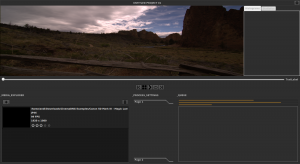Difference between revisions of "Open Cine"
From apertus wiki
BAndiT1983 (talk | contribs) |
BAndiT1983 (talk | contribs) |
||
| Line 41: | Line 41: | ||
=System requirements= | =System requirements= | ||
* OpenGL 3.3 or higher | |||
=Screenshots= | =Screenshots= | ||
Revision as of 13:51, 5 January 2015
1 Feature Overview
- Import Footage from Camera over network (FTP Transfer to backup location)
- Import Footage from local drive
- Preview Footage in real-time (GPU based raw debayering at full/reduced resolution [Reduced resolution equates to better playback performance])
- View(all) / Edit(some) Metadata
- Set IN/OUT points in footage
- Apply color relevant RAW transformations (Whitebalance, Exposure, Curves, etc.)
- Save/Load color transformation presets to/from File.
- Adjustments are preserved in a XMP file that stays with the original unaltered footage.
- Compare Color transformations (Presets A,B,C; split screen, etc.) of the same clip or of different clips
- Live Histogram/Vectorscope
- Batch Export RAW footage between IN/OUT to non destructive RAW conforming format (DNG, DPX, etc.)
- Batch Export RAW footage between IN/OUT to destructive digital intermediate format (Quicktime Prores444, AVI DNxHD, Image Sequence, etc.)
- Batch Export RAW footage between IN/OUT to destructive proxy format (Quicktime Prores422 (proxy), Quicktime/AVI MJPEG, etc.)
2 State of Development
A basic GUI is loading/displaying DNG sequences is working. Open Cine is created in C++ with the QT5 framework.
3 Ideas & Brainstorming
There are several ways how Open Cine development could be started:
- Use blender source code as base and remove everything from the interface that we don't need and add raw processing/import functionality.
- Use a raw development still software source code (like darktable or raw therapee) as base and add motion picture/node support functionality.
- Start from scratch (most work but most individual/fitting outcome)
3.1 Real time RAW preview
2 Approaches:
- Read raw bayer pattern data and reduce resolution with pixel skipping (every 2nd, 3rd, 4th, etc. pixels) then do debayering in GLSL shader. We already have the python written Stereocamcheck software that uses GLSL shaders to debayer JP4 RAW in real time. The footage is read via Gstreamer.
- Read raw bayer pattern data and generate RGB values from 2x2 photosite block which contains 2 green, 1 red and 1 blue value. This automatically reduces the resolution by half in both horizontal and vertical axis. Further resolution reductions could be done by skipping every 2nd, 3rd, etc. 2x2 photosite block.
4 Plan and Structure
5 Wishlist
The apertus° Lab: http://lab.apertus.org/project/view/19/
6 System requirements
- OpenGL 3.3 or higher
7 Screenshots
7.1 Version 0.1 Alpha
8 Developer information
9 Useful links
9.1 Basics
http://wolfcrow.com/blog/the-advantages-of-working-in-32-bit-float/
http://www.is.uni-due.de/fileadmin/literatur/publikation/herwig11spie.pdf
http://users.soe.ucsc.edu/~rcsumner/rawguide/RAWguide.pdf
http://www.siliconimaging.com/DigitalCinema/Files/CameraRawWorkflows.pdf
DNG Test Footage: http://neumannfilms.mediafire.com/?o8ea1dxfrj9fwj9
